
Affiliate marketing : a good courier 2022?
Affiliate marketing: A good courier 2022?
Now before I dive into affiliate marketing, let me tell you why you should care.
Ever since the 4-Hour Workweek was released, everyone seems to have the same goal.

That’s the dream, right?
Make money while you sleep.
Ready to find out more? Let’s start with the basics—what it is and who uses it.
What Is Affiliate Marketing?
Affiliate marketing is promoting other people’s products in return for a small commission for each sale. You’ve probably seen headings marked “affiliate link” or “sponsored post” on many of the websites you visit, or maybe you’ve already taken the first step and signed up to an affiliate network.
If you are new to affiliate marketing, let’s cover how it works.
First, find an affiliate program or network you are interested in. Look at the program overview, including the type of products or services, payment methods, and commissions they offer.
If it appeals to you, sign up and wait for confirmation of your acceptance. Then, start creating content, adding the custom links the program provides. Those links track when one of your users makes a purchase, and you’ll earn a small commission.
You can work with individual companies or affiliate networks, where you register and choose the programs that interest you. The programs are generally divided into categories to make selection easier. Once approved, start promoting your affiliate links on your website, in newsletters, on social media, and anywhere else you’re permitted to share links.
Affiliate marketing is a popular tactic to drive sales and generate significant online revenue. Extremely beneficial to both brands and affiliate marketers, the new push towards less traditional marketing tactics has paid off. In fact:
- 81% of brands and 84% of publishers leverage the power of affiliate marketing, a statistic that will continue to increase as affiliate marketing spending increases every year in the United States.
- There is a 10.1% increase in affiliate marketing spending in the United States each year, meaning that by 2020, that number will reach $6.8 billion.
- In 2018, content marketing costs were gauged to be 62% of traditional marketing schemes while simultaneously generating three times the leads of traditional methods. In fact, 16% of all orders made online can be attributed to the impact of affiliate marketing.
- In March of 2017, Amazon’s affiliate structure changed, offering rates of 1-10% of product revenue for creators, providing the opportunity for affiliates to dramatically increase their passive income based on the vertical they’re selling on.
- The affiliate marketing of Jason Stone, otherwise known as Millionaire Mentor, was responsible for as much as $7 million in retailer sales just in June and July in 2017.
How Does Affiliate Marketing Work?
Because affiliate marketing works by spreading the responsibilities of product marketing and creation across parties, it manages to leverage the abilities of a variety of individuals for a more effective marketing strategy while providing contributors with a share of the profit. To make this work, three different parties must be involved:
- Seller and product creators.
- The affiliate or advertiser.
- The consumer.
Let’s delve into the complex relationship these three parties share to ensure affiliate marketing is a success.
1. Seller and product creators.
The seller, whether a solo entrepreneur or large enterprise, is a vendor, merchant, product creator, or retailer with a product to market. The product can be a physical object, like household goods, or a service, like makeup tutorials.
Also known as the brand, the seller does not need to be actively involved in the marketing, but they may also be the advertiser and profit from the revenue sharing associated with affiliate marketing.
For example, the seller could be an e-commerce merchant that started a dropshipping business and wants to reach a new audience by paying affiliate websites to promote their products. Or the seller could be a SaaS company that leverages affiliates to help sell their marketing software.
2. The affiliate or publisher.
Also known as a publisher, the affiliate can be either an individual or a company that markets the seller’s product in an appealing way to potential consumers. In other words, the affiliate promotes the product to persuade consumers that it is valuable or beneficial to them and convince them to purchase the product. If the consumer does end up buying the product, the affiliate receives a portion of the revenue made.
Affiliates often have a very specific audience to whom they market, generally adhering to that audience’s interests. This creates a defined niche or personal brand that helps the affiliate attract consumers who will be most likely to act on the promotion.
3. The consumer.
Whether the consumer knows it or not, they (and their purchases) are the drivers of affiliate marketing. Affiliates share these products with them on social media, blogs, and websites.
When consumers buy the product, the seller and the affiliate share the profits. Sometimes the affiliate will choose to be upfront with the consumer by disclosing that they are receiving commission for the sales they make. Other times the consumer may be completely oblivious to the affiliate marketing infrastructure behind their purchase.
Either way, they will rarely pay more for the product purchased through affiliate marketing; the affiliate’s share of the profit is included in the retail price. The consumer will complete the purchase process and receive the product as normal, unaffected by the affiliate marketing system in which they are a significant part.
payment process.
A quick and inexpensive method of making money without the hassle of actually selling a product, affiliate marketing has an undeniable draw for those looking to increase their income online. But how does an affiliate get paid after linking the seller to the consumer?
The answer can get complicated.
The consumer doesn’t always need to buy the product for the affiliate to get a kickback. Depending on the program, the affiliate’s contribution to the seller’s sales will be measured differently.
The affiliate may get paid in various ways:
1. Pay per sale.
This is the standard affiliate marketing structure. In this program, the merchant pays the affiliate a percentage of the sale price of the product after the consumer purchases the product as a result of the affiliate’s marketing strategies. In other words, the affiliate must actually get the investor to invest in the product before they are compensated.
2. Pay per lead.
A more complex system, pay-per-lead affiliate programs compensate the affiliate based on the conversion of leads. The affiliate must persuade the consumer to visit the merchant’s website and complete the desired action — whether it’s filling out a contact form, signing up for a trial of a product, subscribing to a newsletter, or downloading software or files.
3. Pay per click.
This program focuses on incentivizing the affiliate to redirect consumers from their marketing platform to the merchant’s website. This means the affiliate must engage the consumer to the extent that they will move from the affiliate’s site to the merchant’s site. The affiliate is paid based on the increase in web traffic.
Sometimes also known as the creator, the seller, the brand, the retailer, or the vendor. This is the party that creates the product. It can be a big company, like Dyson, which produces vacuum cleaners.
Or, it can be a single individual like Mariah Coz, who sells online courses to female entrepreneurs.
From solo entrepreneurs to startups to massive Fortune 500 companies, anyone could be the merchant behind an affiliate marketing program. They don’t even have to be actively involved. They just have to have a product to sell.
The Consumer
The customer or consumer makes the affiliate system go ’round. Without sales, there aren’t any commissions to hand out and no revenue to be shared.
The affiliate will try to market to the consumer on whatever channel they see fit, whether that’s a social network, digital billboards, or through a search engine using content marketing on a blog.
The consumer needs to know they are part of an affiliate marketing system. Usually a short disclaimer like “If you purchase items on this site, I may earn a small commission. Thanks for supporting our work.” is fine.
The consumer will not typically pay a higher price to the affiliate marketer, as the cost of the affiliate network is already included in the retail price.
The Affiliate Network
Only some consider the network part of the affiliate marketing equation. However, I believe that an affiliate marketing guide needs to include networks, because, in many cases, a network works as an intermediary between the affiliate and the merchant.
While you could technically promote someone else’s course and arrange a direct revenue share with them, letting a network such as ClickBank or Commission Junction handle the payment and product delivery puts a more serious note on your affiliate marketing.
Sometimes, affiliates have to go through an affiliate network to even be able to promote the product. For example, this happens if the merchant only manages their affiliate program on that network.
The affiliate network then also serves as a database of lots of products, out of which the affiliate marketer can choose which to promote.
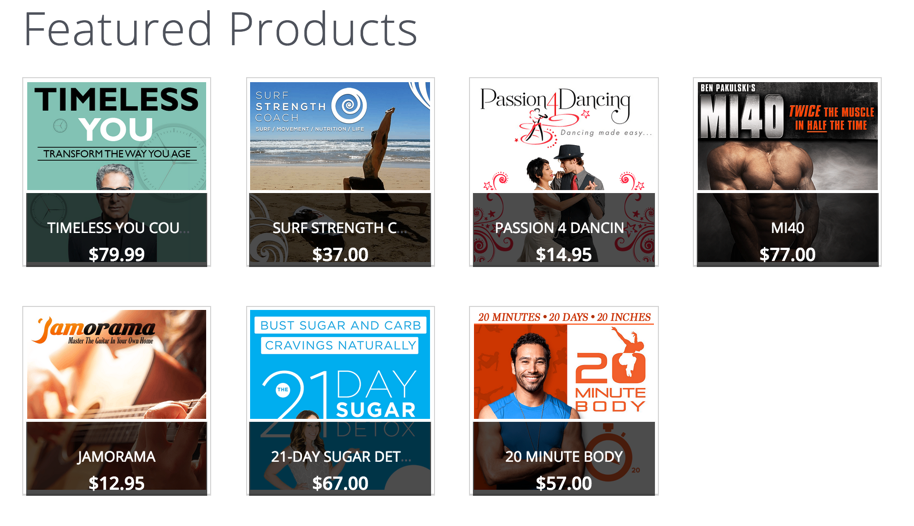
Clickbank is an example of an affiliate network.
In the case of promoting consumer products, like tools, books, toys, and household items, the biggest affiliate network, by far, is Amazon.
Their Amazon Associates affiliate program lets you promote any item that is sold on their platform.
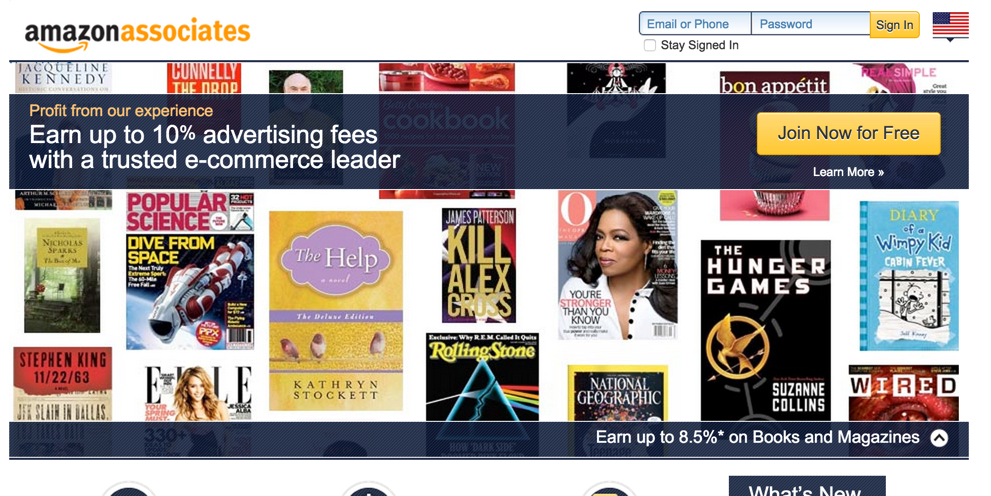
Anyone can sign up and then generate a custom affiliate link to Amazon products. If someone purchases through your link, you earn a small commission.
With the basic terms clarified, let’s get an overview of how you can best get started with building your affiliate marketing business.
As I said, there are basically two sides of the affiliate marketing equation to choose from, assuming you are not going to build an affiliate network like Commission Junction.
You can become a merchant and have others promote your product, in exchange for giving them a commission from the sales that they make.
Or, you can become an affiliate marketer for several products and market those to consumers, to make money.
While most people start by taking the affiliate route and it definitely is the easier path to take, building enough traffic to make a meaningful income just from affiliate sales isn’t quick or easy.
That’s why I’ll walk you through the four basic steps to get started on both sides of the affiliate marketing industry.
How to Become an Affiliate Merchant? (step by step).
If you want to become an affiliate program merchant and then make money by having affiliates sell your product, here are the steps to follow.
First, you need to have a product idea. I’ll show you a few ways to generate those ideas, based on what’s already popular, in the next section.
Second, you have to validate your idea. You could just go ahead and build your idea. What if people don’t even want it? An idea is only good if people want it to come to life.
Third, you have to create the product. Since creating a physical product usually comes with huge investment and risks, I’ll only show you ways to create digital products. These are the best place to get started since they typically only require your time and little or no money.
Also, once your product is created and released, you need to find affiliates to promote your product — this is where affiliate networks can help.
Step 1: Coming Up with an Affiliate Product Idea
If you want to make money with an affiliate marketing business, you can’t be attached to your idea.
Instead, just look at what products and services are already out there. Consider how you can improve upon them, by delivering something that solves the problems with those products.
You can, of course, always, choose a topic you’re interested in or involved in.
Imagine you’re a stay-at-home parent, for a second.
Maybe you want to create a product that makes household chores easier. For example, you could look for a vacuum robot to get some ideas.
This is the first Google result, a review site for robot vacuums:
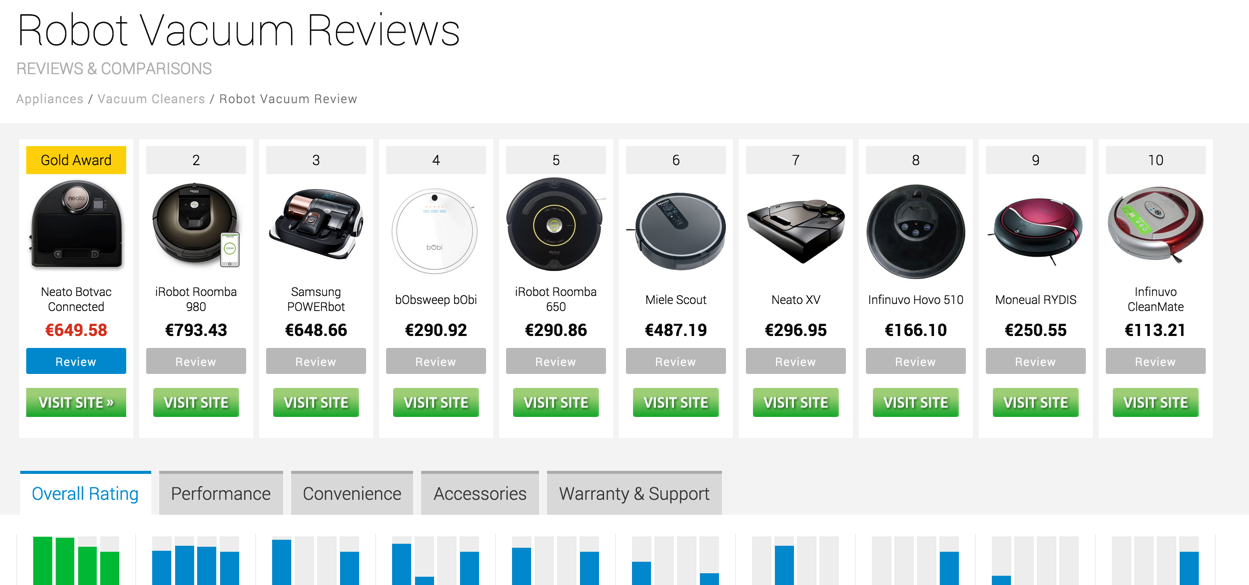
Perfect!
Just by looking at the individual reviews, you can instantly see what’s bad about these robots and what you could potentially improve upon.
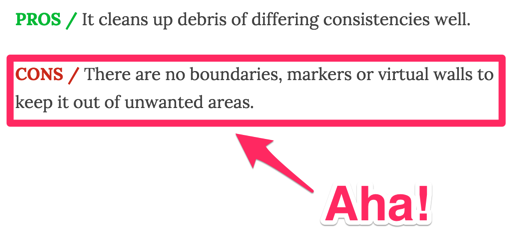
No virtual walls that tell the robot where to go and where not to go is a common problem, mentioned in six out of the ten reviews of the top products!
Lack of remote control was also a common ‘con.’
However, the virtual wall came up again and again and again.

Therefore, a great idea could be to develop a virtual wall that works for all vacuum robots.
I imagine you could sell anyone who owns a vacuum robot a system that works as a virtual wall, so their robot only cleans a predefined space.
Now that’s a valid idea!
This works for anything, I’ll show you.
Another way to do research is to use a tool called Buzzsumo, which shows you what’s popular, based on social shares.
Even if you’re into building sandcastles, you can instantly see what content has been recently popular.

If you go on YouTube and search for ‘build a sandcastle,’ you’ll find thousands of results.
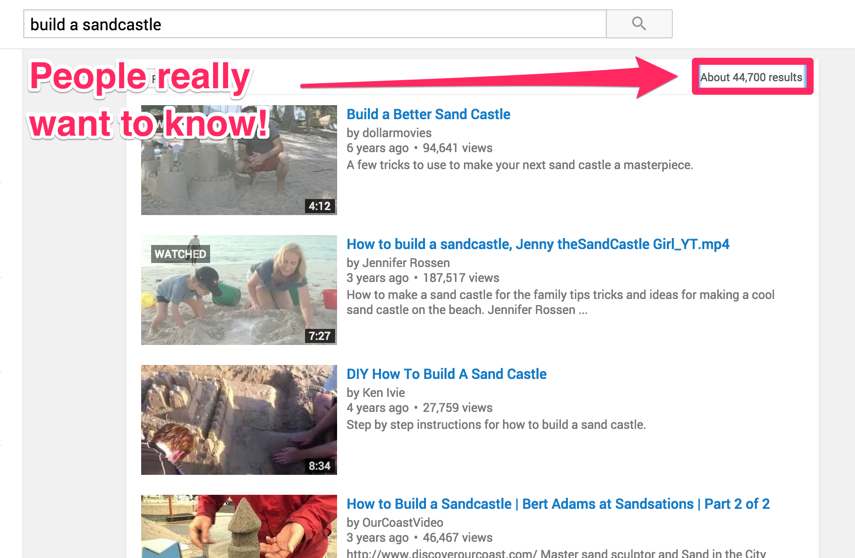
Apparently, people really want to know how to build cool sandcastles. So, what could you do?
Record a series of videos where you show people, step-by-step, how to build 5 very specific, epic sandcastles.
Or, you can do a write-up of all of the tools you need to build epic sandcastles.
You could even come up with some forms or stencils that people can use to make building epic sandcastles a whole lot easier.
The question is…will people pay for it?
Step 2: Validate Your Idea
To not end up doing a great series of sandcastle videos that no one wants to buy, you have to first validate your idea.
How do you do that?
Simple: You ask people to pay you for it.
How do you find these people? Easy.
Take the URL from one of the sandcastle posts on Buzzsumo and plug it into a tool like Keyhole.
They’ll give you a list of people who tweeted a link or about specific topics.
You can then directly tell them about your idea, by hitting the reply button…
Make sure to ask them whether or not they would buy your idea — not just if they like it.
Anyone will say that they like something just to be nice.
If they respond with a yes, you need to directly follow up with an ask to buy.
Saying they will spend money is not the same as spending it.
When people are interested in your product, give them a chance to buy. You can simply use PayPal and say you’re going to build it if you get a certain amount of orders.
Once you cross your threshold and make sure that people want it, you can start creating the product.
Step 3: Create the Product
There are a ton of steps to follow for creating a product and this isn’t an entrepreneurship guide, but I want to point you to some good starters.
I’m only giving you resources for starting digital products because I don’t want you to waste precious time and money on creating a physical product on your first try 🙂
Online courses:
- How to launch an online course and make $220,750 in 10 days
- How To Create & Sell Your Online Course The Right Way
- SPI 136: How to Build an Online Course that Sells with David Siteman Garland
Ebooks:
- The Ultimate Guide to Publishing Your eBook on Amazon’s Kindle Platform
- How to (Really) Make $1,000,000 Selling E-Books – Real-World Case Studies
- How to Start to Write an eBook and Actually Finish it in 30 Days
Podcast/Audio:
- Podcasting for Beginners: The Complete Guide to Getting Started With Podcasts
- How to Start a Podcast – Pat’s Complete Step-By-Step Podcasting Tutorial
- How To Podcast: The Ultimate Guide to Podcasting
These are good starting points. Creating digital products is a lot easier, since it just takes time and sometimes a little financial investment, but usually not more than a service fee or a one-time price for the software.
Once you have the product created and delivered to your initial buyers, it’s time to open up the affiliate network.
Step 4: Finding Affiliate Program Partners
The tech part is the easy thing here.
With tools like Gumroad or Digital Product Delivery, you can easily set up affiliate program partners and allow them to collect commissions.
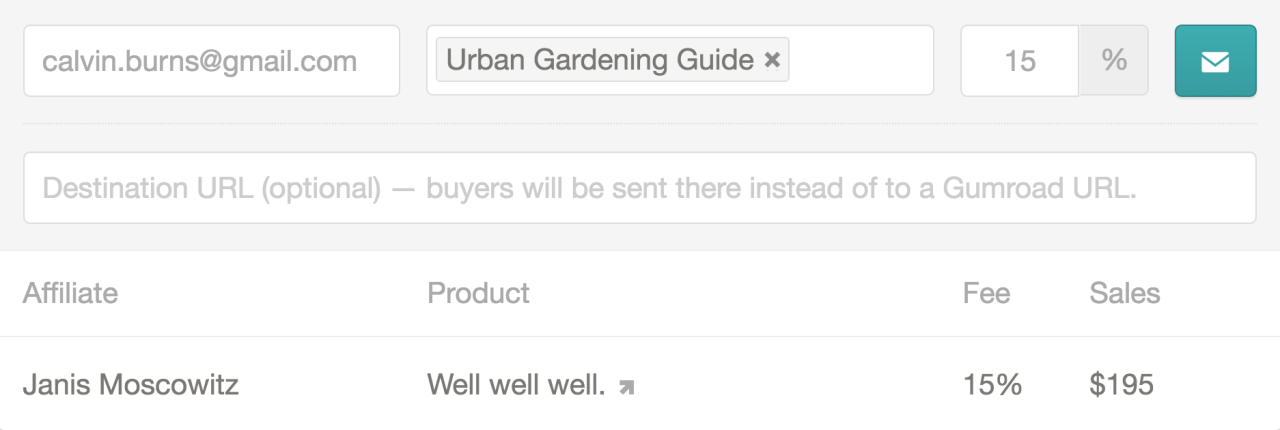
The tough part is finding partners who have an audience that is interested in what you have to sell.
Let’s stick with the sandcastle guide example.
Do you think there’s anyone out there who sells something remotely related?
Actually, there is.
When you enter “learn to build sandcastles,” into a search engine, several sites pop up that sell educational material about it.
Loke SandCastle Lessons, which offers classes on the subject:
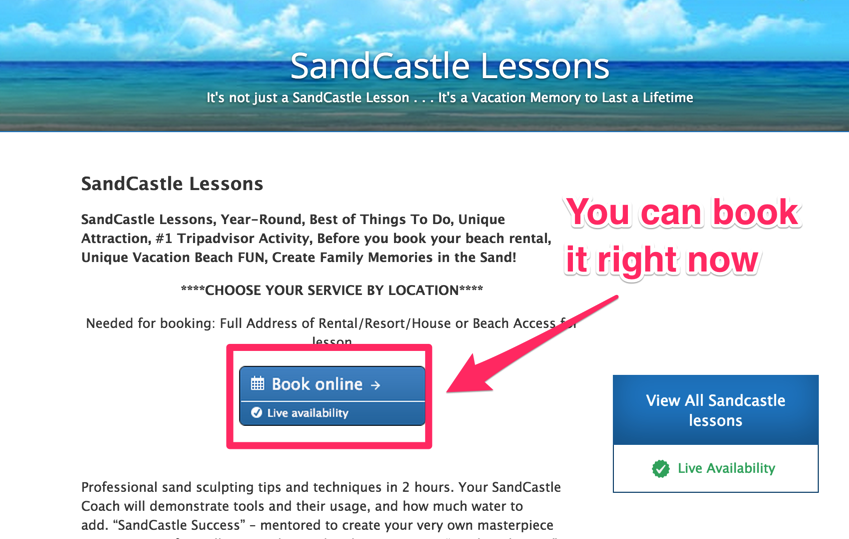
Partnering up with them on a sale together would be an easy pitch because it’s a perfect fit.
The more niche your product is, the easier it will be to pitch to fellow merchants.
You can simply send them an email, introduce yourself and your product and ask them if they want to partner on a sale together, where you’ll share revenue.
Pro tip: Affiliate commissions of 50 percent or higher are very common with digital products because you have no cost of replication. Don’t be greedy here, split the pot evenly and everyone wins.
Googling “toy review blog” also gives plenty of results, where people write toy reviews.

What’s more, lots of YouTube channels review specific categories of toys. If you find one that reviews kids’ toys, they’d probably also be a good fit for your affiliate product.
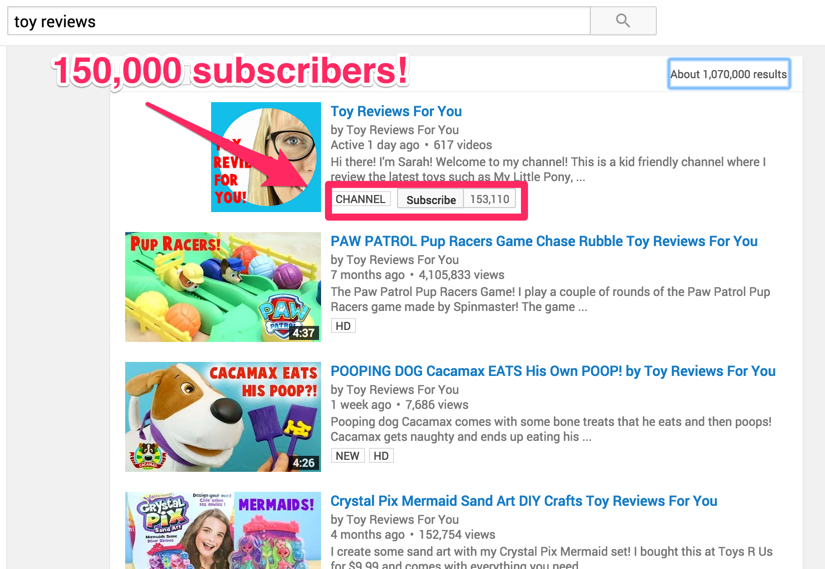
Just try finding one person to partner up with and start your first affiliate promotion. You can adjust commissions and details later, the important part is to get started. Or if you need help, you can always work with an affiliate marketing agency that can help you kick start things.
However, you could also start the journey on the other side of the fence and just become an affiliate yourself.
* 4 Steps to Become an Online Affiliate Marketer (step by step).
Similar to becoming a merchant, there are also four steps to start your journey as an affiliate marketer.
First, you need to start reviewing products in your niche. That can be done on a YouTube channel, on a blog, or even just using live streams on Periscope.
Second, you have to collect emails, so you can connect with your audience at any time you want and don’t have to hope for them to see your content.
Third, you can use joint venture webinars to make a lot of sales in a short period, while simultaneously growing your email list and creating new content.
Finally, once your affiliate marketing business starts making money, you can scale your growth with pay-per-click advertising.
Step 1: Review Products in Your Niche
It’s easier to get started as an affiliate because you’re skipping the ‘have an idea’ and ‘creating an idea’ parts of becoming a merchant.
You already use and like plenty of products, so all you have to do to get started is to publicly talk about them.
Start by looking at the partners in step 4 for becoming a merchant, because that’s what you’re trying to start in this step.
Any product works.
Really.
Take a look at this guy, who reviews Hot Wheels tracks and cars:
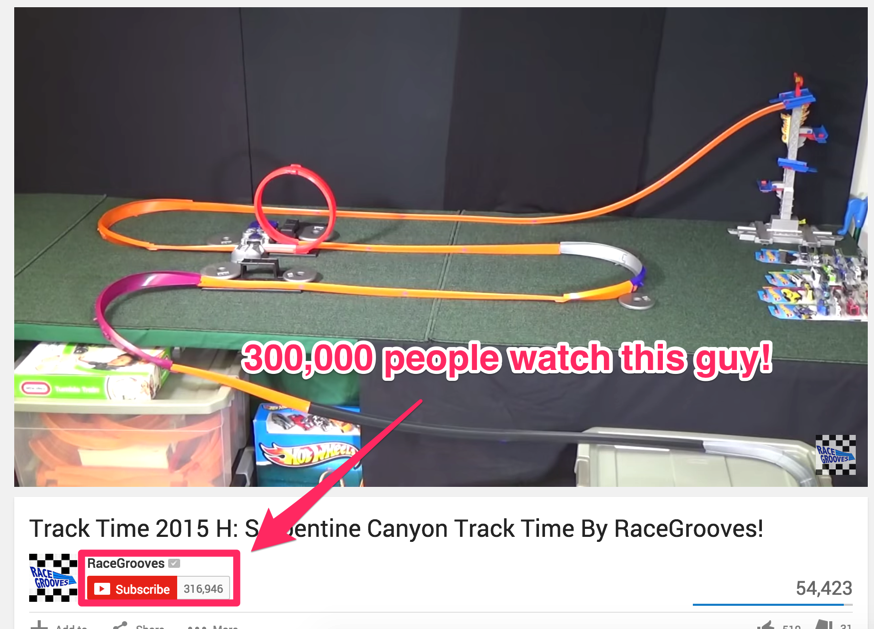
Over 300,000 subscribers for Hot Wheels? I’m sure whatever your niche is, it’s less specific.
If you like reading, review books:
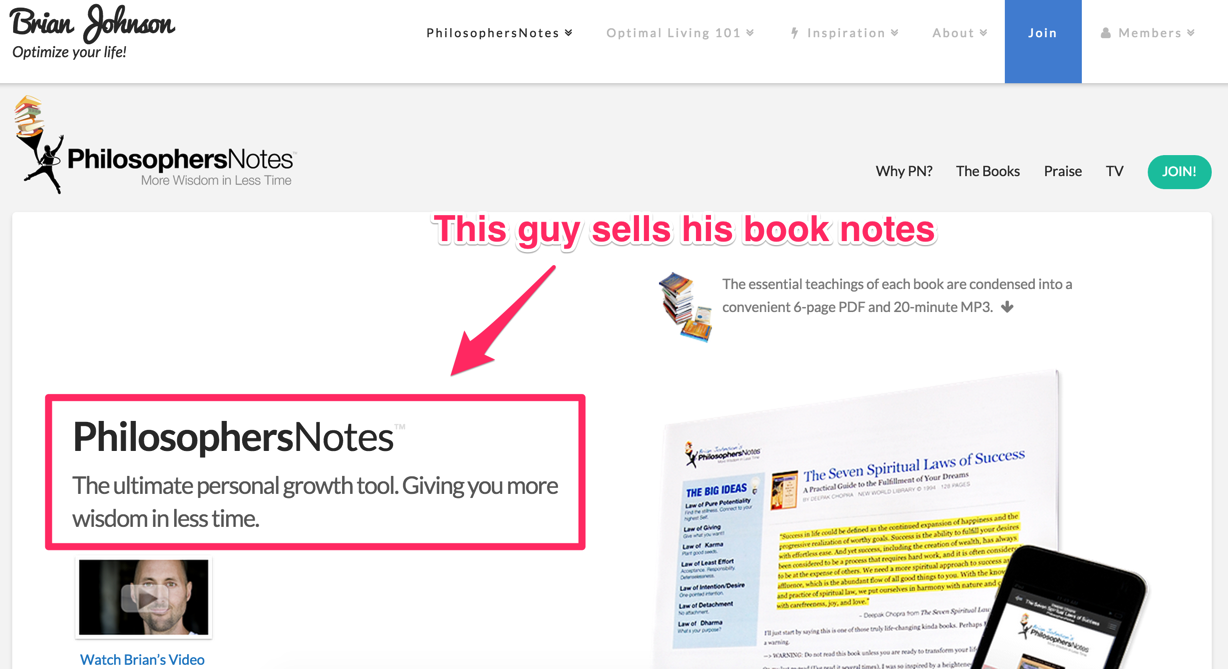
Note: A special kind of review, that usually does really well, is the comparison with a direct competitor.
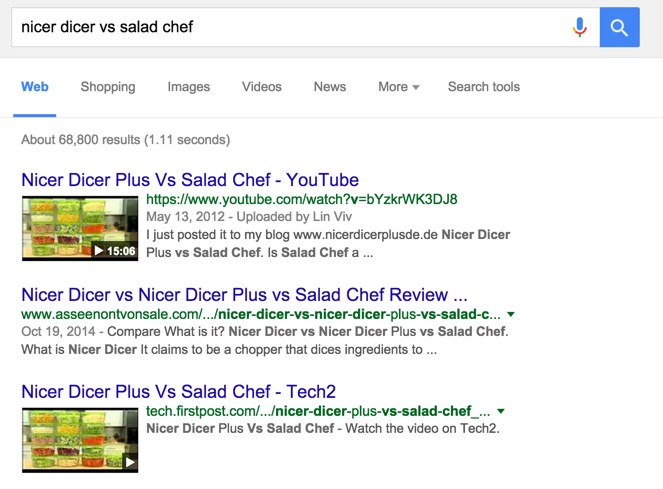
Whatever you’re reviewing, make sure you are honest and even-handed.
If your reviews aren’t genuinely helpful, people will sense immediately that you’re just trying to make a quick buck.
As Pat Flynn points out, in his affiliate marketing guide, involved affiliate marketing is by far the most profitable, because you can relate to the product, instead of just promoting something that might make you a lot of cash.
When you don’t even know the product, how can you credibly promote it?
Note: This is a little different for consumer products than it is for online courses or books created by individuals. If you’ve known a person for a long time and trust them and know their work is great, then that’s a different thing.
When you write reviews on your blog, you can use an affiliate link to link to the products you promote.
You can recognize them on other blogs by the long “/ref…” tail, at the end of the regular link.

This is usually the first step to start making commissions.
Simply sign up to Amazon Associates and you can then proceed to get your own affiliate link to any product on Amazon.
Just go to the product page and click on “Share affiliate link.” You’ll get a link that’ll give you a commission if people purchase through it.

However, if you only rely on people using the affiliate links in your reviews, you need lots of traffic to start making serious money.
If you can contact your audience directly, you can market to them whenever you like, not just when they come to your website.
This is where step two comes in.
Step 2: Build an Email List of Your Prospects
Email is still one of the best marketing channels today, so don’t miss out on it.
I’ll show you a few super easy ways to collect email addresses from your website visitors.
The first is Hello Bar
Hello, Bar puts a call to action on top of your website. Whenever someone visits your website, they’ll see this bar at the top.
You can offer them an ebook (maybe bundle together your 3 best product reviews) or a special review video.
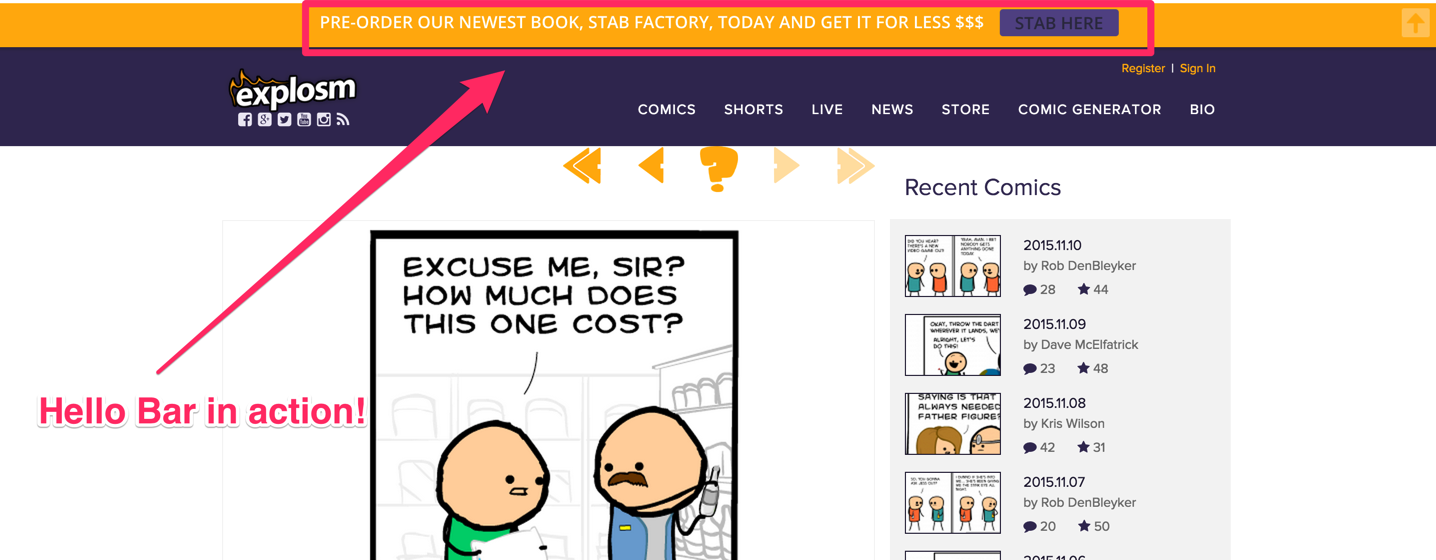
Once they click on your Hello Bar, you can redirect people to the page where they can enter their email in exchange for the content.
You can also use Hello Bar to create an exit gate. This is a popup that will lay over the screen when visitors are about to leave your website.
It is triggered by their mouse moving to the top area of the browser.
I use it to get more Facebook likes on Quick Sprout:
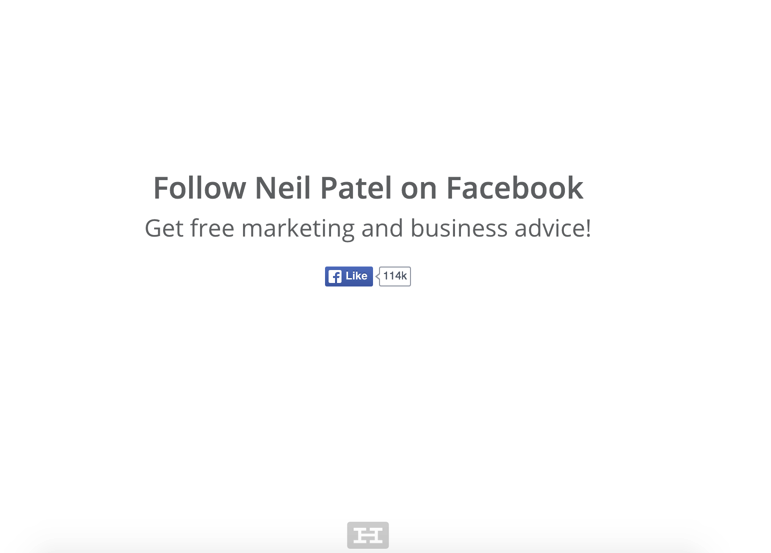
You can also redirect people to your lead magnet and get their email address this way.
Just don’t overdo it.
If you give your visitors 20 things to do, it’s unlikely that they’ll do anything at all.
Just have one call to action in your sidebar. Again, it should offer people something in exchange for their email addresses.
Since you’re collecting email addresses around a very specific topic, such as finding the best straightening iron, juice maker, mini-oven, etc., you don’t need a lot of them to make the email list worth your time.
Even with less than 500 people on your list, you can create significant sales.
Just make sure to keep your audience engaged, by sending them regular updates, ideally once a week.
Don’t make it all sales. Just let them know when you have a new review up.
For example, I email out every single post that we do on Quick Sprout with a very simple description of what it’s about:

Every now and then, send them a specific call to action to buy a product. Perhaps you just found a new favorite in the latest review and think it’s really great.
You can update your audience on your change of mind, the reasons why and recommend that they switch to that product also.
Step 3: Educate Your Audience With Webinars
Webinars are awesome.
Imagine you want to buy a new fridge.
What makes you want to buy a fridge more:
- Reading a review on a blog
- Seeing a live presentation of a fridge in action
Number two, of course!
Using a tool like LeadPages, you can create a simple landing page where people can sign up for your webinar.
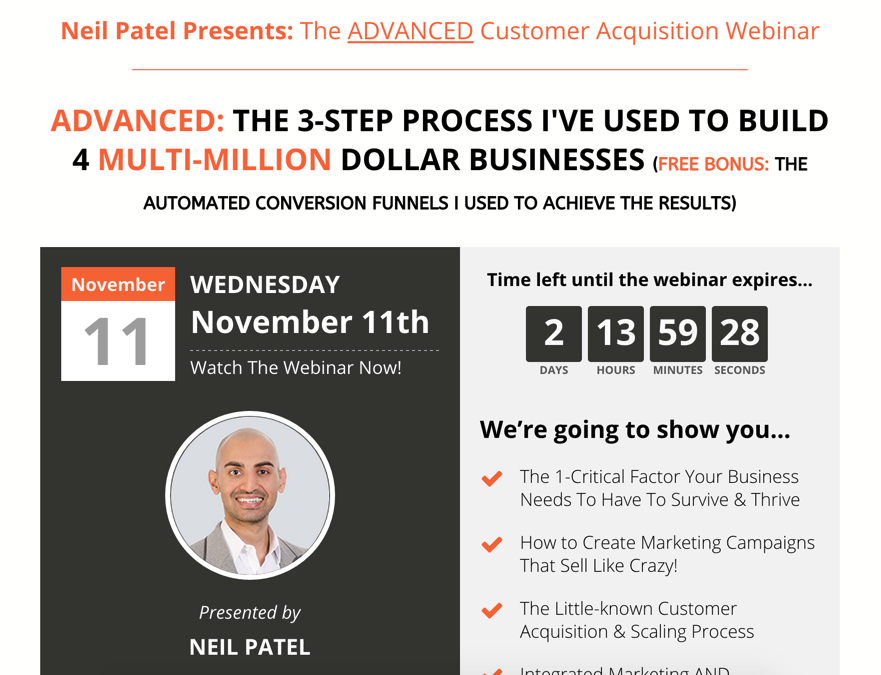
Promote your webinar on social media a week in advance and get people to sign up.
Webinars are great to engage with your audience one on one, show them the product you’re promoting live and answer any questions that they might have.
You can:
- present the product’s features
- show different use cases of the product
- talk about its benefits and drawbacks
- tell people your personal history with the product
- help your audience get the most out of it
Imagine how fired up your audience will get when they see all of the cool things your product can help them do.
Pointing to your affiliate link and sharing it at the end of the webinar is a soft sell and comes naturally since you just spent an hour talking about the product.
It won’t feel forced and your consumers can still take all of the time that they want to make up their mind on whether they’ll actually buy.
Pro tip: Can you get your merchant to give you a special deal for your audience? If you promise to get their product in front of a couple hundred people, they’ll often happily give you a discount or special bundle to further incentivize people to buy.
Step 4: Grow Your Business with PPC Advertising
Once your affiliate marketing business starts to pick up steam, you can start thinking about paid advertising.
I’m not going to show you how to do it here, since I recently published a guide on both Facebook Ads, as well as Google ads, but remember: only do this once you have a way of making back your money.
Conversions are all that matters here.
You can use PPC advertising to:
- get people to sign up for your webinar
- grow your email list
- make more sales
For example, if you Google “learn lead pages,” you can see that LeadPages themselves are advertising for this keyword, running Google ads, promoting their weekly live webinar.
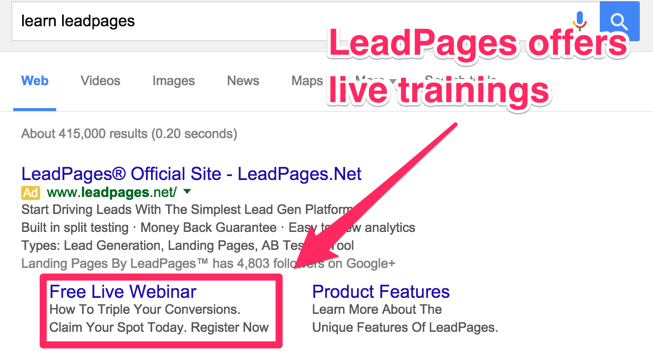
So, keywords related to learning about your product or topic would be a good start.
You can also target your competition. For example, right under the LeadPages ad, there’s an ad from Unbounce.

These guys also provide software for creating landing pages, so it’s an easy way for them to get in front of someone else’s audience.
Now, while you could try to target people who are just trying to find a review of your product, you’d probably be better off improving your SEO.
The percentage of people who buy straight through your link after reading a review is naturally low, so imagine paying for these reads. Depending on the product price, you only get a few dollars or even cents per sale, so the margin you can spend on ads is not very big.
In most cases, your best off promoting sign-ups to your email list.
As a matter of fact, getting people to sign up for a webinar with ads is the best way to go.

You will win in three ways:
- They’ll be on your email list and you can contact them again at any time
- There’s a chance that they’ll attend your live webinar and buy the product
- You can put them on an autoresponder email sequence that encourages them to buy
For example, John Lee Dumas, from Entrepreneur On Fire, often runs webinars and puts them right on his homepage.
As soon as you opt in to the webinar, he also starts sending you a series of automated emails.
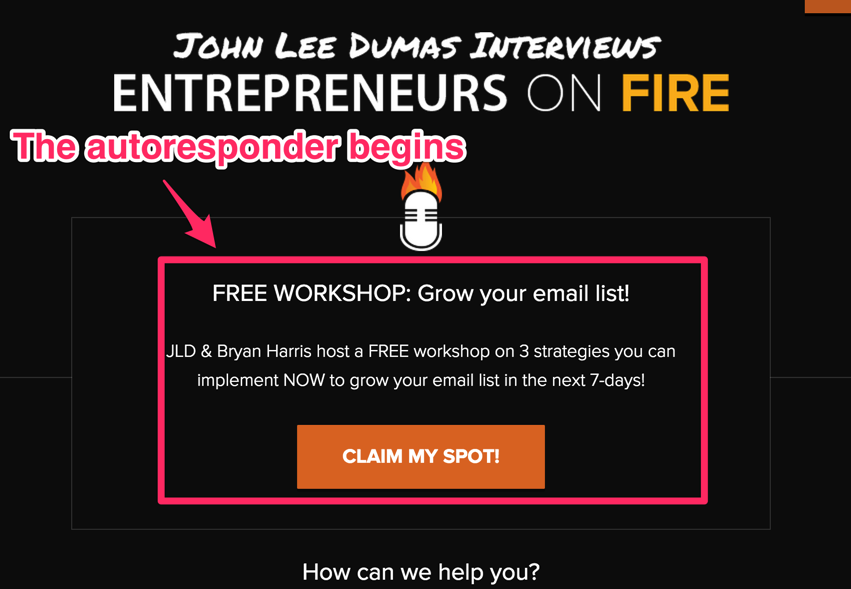
On those emails, he offers you other courses and free tools, like a webinar course, where you’ll learn how to do webinars to make sales.
If you opt into those, you’ll be sent 10 email lessons over several days. In the end, he invites you to buy a more extensive course on webinars.
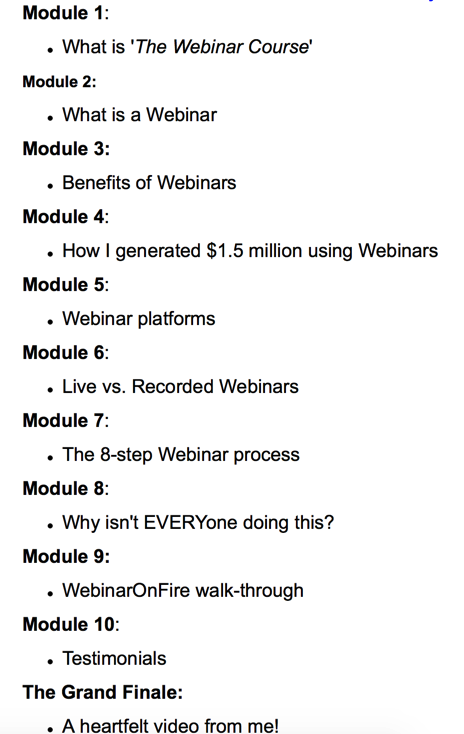
After you’ve already learned a lot about webinars, you’re introduced to his more thorough and detailed course that’ll teach you even more.
He even shows a behind-the-scenes walk-through of the course, so you get a sneak peek.
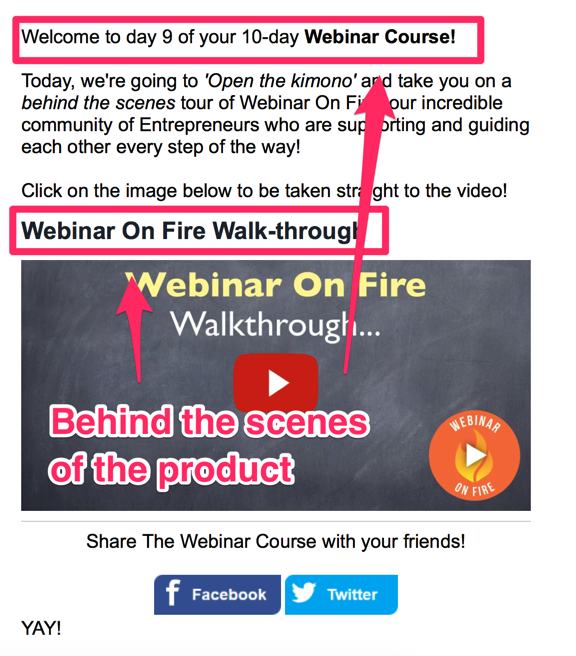
Once he knows how many people will end up buying the full course from the autoresponder series, he can easily calculate how much he can spend on ads to get people to sign up for the webinar or webinar course.
So, with this strategy, you have several chances of getting your consumers to buy your product.
They have a chance to buy after the autoresponder series, on the webinar, and from future emails.
When your sales start coming in from that many sources and begin to grow, that’s when you can really blow up your business with paid advertising by just driving traffic to the sales mechanisms that already work.
Common Types of Affiliate Marketing Channels
Most affiliates share common practices to ensure that their audience is engaged and receptive to purchasing promoted products. But not all affiliates advertise the products in the same way. In fact, there are several different marketing channels they may leverage.
1. Influencers.
An influencer is an individual who holds the power to impact the purchasing decisions of a large segment of the population. This person is in a great position to benefit from affiliate marketing. They already boast an impressive following, so it’s easy for them to direct consumers to the seller’s products through social media posts, blogs, and other interactions with their followers. The influencers then receive a share of the profits they helped to create.
Influencer marketing campaigns are particularly popular on Instagram where brands partner with influencers who are seen as experts or authorities in their specific niches. Depending on the deal, a campaign could consist of a series of product reviews with photos, account takeovers, or live videos. While an influencer might have their own branding and aesthetic, it’s important to add elements that tie-up with your brand to ensure brand recall and recognition. This can be achieved by using apps like Instasize where you can quickly edit and customize your campaign’s creatives in a tap.
2. Bloggers.
With the ability to rank organically in search engine queries, bloggers excel at increasing a seller’s conversions. The blogger samples the product or service and then writes a comprehensive review that compellingly promotes the brand, driving traffic back to the seller’s site.
The blogger is awarded for his or her influence in spreading the word about the value of the product, helping to improve the seller’s sales. For example, my article on the best email marketing software includes product reviews and affiliate links.

3. Paid search-focused microsites.
Developing and monetizing microsites can also garner a serious amount of sales. These sites are advertised within a partner site or on the sponsored listings of a search engine. They are distinct and separate from the organization’s main site. By offering more focused, relevant content to a specific audience, microsites lead to increased conversions due to their simple and straightforward call to action.
4. Email lists.
Despite its older origins, email marketing is still a viable source of affiliate marketing income. Some affiliates have email lists they can use to promote the seller’s products. Others may leverage email newsletters that include hyperlinks to products, earning a commission after the consumer purchases the product.
Another method is for the affiliate to build an email list over time. They use their various campaigns to collect emails en masse, then send out emails regarding the products they are promoting.
5. Large media websites.
Designed to create a huge amount of traffic at all times, these sites focus on building an audience of millions. These websites promote products to their massive audience through the use of banners and contextual affiliate links. This method offers superior exposure and improves conversion rates, resulting in top-notch revenue for both the seller and the affiliate.
Other Tips to Help You Become A Successful Affiliate Marketer 2022!!
1. Develop a rapport.
When beginning your affiliate marketing career, you’ll want to cultivate an audience that has very specific interests. This allows you to tailor your affiliate campaigns to that niche, increasing the likelihood that you’ll convert. By establishing yourself as an expert in one area instead of promoting a large array of products, you’ll be able to market to the people most likely to buy the product.
2. Make it personal.
There is no shortage of products you’ll be able to promote. You’ll have the ability to pick and choose products that you personally believe in, so make sure that your campaigns center around truly valuable products that consumers will enjoy. You’ll achieve an impressive conversion rate while simultaneously establishing the reliability of your personal brand.
You’ll also want to get really good at email outreach to work with other bloggers and influencers. Use a tool like ContactOut or Voila Norbert to gather people’s contact information and send personalized emails to garner guest blogging and affiliate opportunities.
3. Start reviewing products and services.
Focus on reviewing products and services that fall within your niche. Then, leveraging the rapport you have created with your audience and your stance as an expert, tell your readers why they would benefit from purchasing the product or service you are promoting. Almost anything sold online can be reviewed if there is an affiliate program – you can review physical products, digital software, or even services booked online, like ride-sharing or travel resort booking. It is especially effective to compare this product to others in the same category. Most importantly, make sure you are generating detailed, articulate content to improve conversions.
4. Use several sources.
Instead of focusing on just an email campaign, also spend time making money with a blog, reaching out to your audience on social media, and even looking into cross-channel promotions.
Test a variety of marketing strategies to see which one your audience responds to the most. Make frequent use of this technique.
For more information, you can check out this article on how to start a successful blog this year.
5. Choose campaigns with care.
No matter how good your marketing skills are, you’ll make less money on a bad product than you will on a valuable one. Take the time to study the demand for a product before promoting it. Make sure to research the seller with care before teaming up. Your time is worth a lot, and you want to be sure you’re spending it on a profitable product and a seller you can believe in.
6. Stay current with trends.
There is serious competition in the affiliate marketing sphere. You’ll want to make sure you stay on top of any new trends to ensure you remain competitive. Additionally, you’ll likely be able to benefit from at least a few of the new marketing techniques that are constantly being created. Be sure you’re keeping up to date on all these new strategies to guarantee that your conversion rates, and therefore revenue, will be as high as possible.
What are the Top Affiliate Marketing Trends of 2022?
1. Improved affiliate reporting and attribution.
Many affiliate programs run with last-click attribution, where the affiliate receiving the last click before the sale gets 100% credit for the conversion. This is changing. With affiliate platforms providing new attribution models and reporting features, you can see a full-funnel, cross-channel view of how individual marketing tactics are working together.
For example, you might see that a paid social campaign generated the first click, Affiliate X got click 2, and Affiliate Y got the last click. With this full picture, you can structure your affiliate commissions so that Affiliate X gets a percentage of the credit for the sale, even though they didn’t get the last click.
2. Influencer niches are becoming hyper-targeted.
In the past, large affiliates were the mainstay, as catch-all coupons and media sites gave traffic to hundreds or thousands of advertisers. This is not so much the case anymore. With consumers using long-tail keywords and searching for very specific products and services, influencers can leverage their hyper-focused niche for affiliate marketing success. Influencers may not send advertisers huge amounts of traffic, but the audience they do send is credible, targeted, and has higher conversion rates.
3. GDPR is changing how personal data is collected.
The General Data Protection Regulation (GDPR), which took effect on May 25, 2018, is a set of regulations governing the use of personal data across the EU. This is forcing some affiliates to obtain user data through opt-in consent (updated privacy policies and cookie notices), even if they are not located in the European Union. This new regulation should also remind you to follow FTC guidelines and clearly disclose that you receive affiliate commissions from your recommendations.
4. Affiliate marketers are getting smarter.
Merchants receiving a large percentage of their revenue from the affiliate channel can become reliant on their affiliate partners. This can lead to affiliate marketers leveraging their important status to receive higher commissions and better deals with their advertisers. Whether it’s CPA, CPL, or CPC commission structures, there are a lot of high-paying affiliate programs and affiliate marketers are in the driver’s seat.
What Affiliate Marketing Strategies Should You Employ in 2022?
1. Only recommend products you are extremely familiar with.
Building trust with your audience is paramount in affiliate marketing, and the quickest way to lose trust is to recommend products either you haven’t used before or that aren’t a good fit for your audience. Also, make sure you never tell anyone to directly buy a product, you are simply recommending the product. The more helpful you are and the more you make quality recommendations, the more likely your web visitors will come back for your expertise.
2. Promote products from many different merchants.
Don’t put all your eggs in one basket. If you only promote one merchant’s products, you are stuck with their commissions, their landing pages, and ultimately, their conversion rates. It is important to work with many different merchants in your niche and promote a wide range of products.
This affiliate marketing strategy will diversify the number of commissions you make and create a steady stream of revenue when building an affiliate website. Some examples of affiliate merchants include brands like BigCommerce, Bluehost, and SimplyBook.
3. Constantly test and optimize your conversion rates.
Let’s say you have a promotions page where you’re promoting a product via affiliate links. If you currently get 5,000 visits/month at a 2% conversion rate, you have 100 referrals. To get to 200 referrals, you can either focus on getting 5,000 more visitors or simply increase the conversion rate to 4%.
Which sounds easier? Instead of spending months building Domain Authority with blogging and guest posts to get more organic traffic, you just have to increase the conversion rate by 2%. This can include landing page optimization, testing your calls-to-action, and having a conversion rate optimization strategy in place. By testing and optimizing your site, you’ll get far better results with much less effort.

4. Focus on your affiliate traffic sources.
It’s important to know where your traffic is coming from and the demographics of your audience. This will allow you to customize your messaging so that you can provide the best affiliate product recommendations. You shouldn’t just focus on the vertical you’re in, but on the traffic sources and audience that’s visiting your site. Traffic sources may include organic, paid, social media, referral, display, email, or direct traffic.
You can view traffic source data in Google Analytics to view things such as time on page, bounce rate, geolocation, age, gender, time of day, devices (mobile vs. desktop), and more so that you can focus your effort on the highest converting traffic. This analytics data is crucial to making informed decisions, increasing your conversion rates, and making more affiliate sales.
Benefits To Joining the BigCommerce Affiliate Program
1. Industry-leading commissions.
In the BigCommerce affiliate program, you receive a 200% bounty per referral and $1,500 per Enterprise referral, with no cap on commissions. Plus, the more referrals you drive through the program, the higher your commission tier will go. BigCommerce uses an industry leading 90-day cookie, so you will receive credit for up to three months for the referrals you generate. Also, there are no obligations or minimum commitments to join the program.
2. Strategic growth.
BigCommerce provides unique strategies to help you grow, increase your website’s visibility, and drive more sales. You’ll be able to save time and money on content creation by linking to WordPress blogs, webinars, and more with content developed by BigCommerce for your audience.
3. Powerful tracking.
Our affiliate dashboard offers a comprehensive look at your clicks, trials, sales, and commissions. You can view your earnings, track performance, and get paid at the same time every month.
4. A dedicated account manager.
You will have direct access to an affiliate expert who understands your business and your goals. BigCommerce will work with your team and our conversion rate experts to maximize your commissions and earnings per click. We provide 1-on-1 support through phone and email, quarterly affiliate contests, and our latest product updates.
5. Promotion made easy.
In your dashboard, you will have easy access to our pre-made text links, banners, and content. Promote BigCommerce anywhere on your site by simply inserting our affiliate links on your pages.





0 Comments:
If you have any promblem, please let me know!